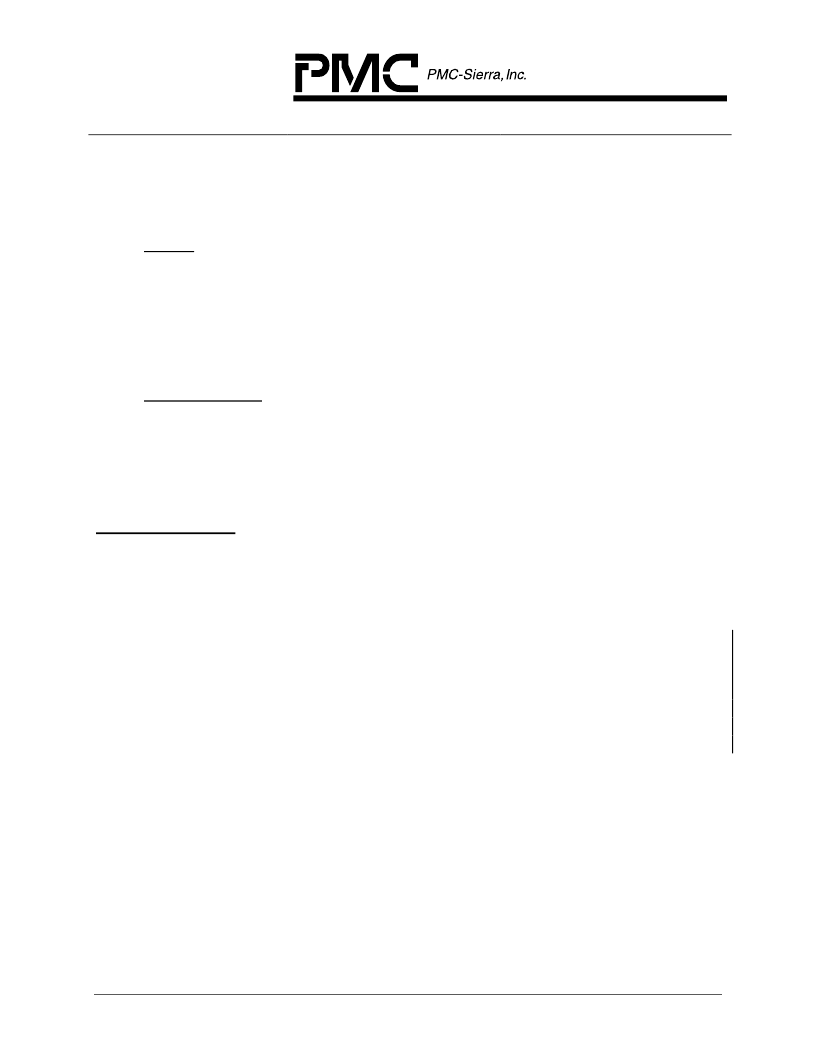- 您現(xiàn)在的位置:買賣IC網(wǎng) > PDF目錄378055 > PM7344 (PMC-SIERRA INC) SATURN QUAD T1/E1 MULTI-PHY USER NETWORK INTERFACE DEVICE PDF資料下載
參數(shù)資料
| 型號(hào): | PM7344 |
| 廠商: | PMC-SIERRA INC |
| 元件分類: | 通信及網(wǎng)絡(luò) |
| 英文描述: | SATURN QUAD T1/E1 MULTI-PHY USER NETWORK INTERFACE DEVICE |
| 中文描述: | SPECIALTY TELECOM CIRCUIT, PQFP128 |
| 封裝: | 14 X 20 MM, PLASTIC, QFP-128 |
| 文件頁(yè)數(shù): | 234/293頁(yè) |
| 文件大小: | 1147K |
| 代理商: | PM7344 |
第1頁(yè)第2頁(yè)第3頁(yè)第4頁(yè)第5頁(yè)第6頁(yè)第7頁(yè)第8頁(yè)第9頁(yè)第10頁(yè)第11頁(yè)第12頁(yè)第13頁(yè)第14頁(yè)第15頁(yè)第16頁(yè)第17頁(yè)第18頁(yè)第19頁(yè)第20頁(yè)第21頁(yè)第22頁(yè)第23頁(yè)第24頁(yè)第25頁(yè)第26頁(yè)第27頁(yè)第28頁(yè)第29頁(yè)第30頁(yè)第31頁(yè)第32頁(yè)第33頁(yè)第34頁(yè)第35頁(yè)第36頁(yè)第37頁(yè)第38頁(yè)第39頁(yè)第40頁(yè)第41頁(yè)第42頁(yè)第43頁(yè)第44頁(yè)第45頁(yè)第46頁(yè)第47頁(yè)第48頁(yè)第49頁(yè)第50頁(yè)第51頁(yè)第52頁(yè)第53頁(yè)第54頁(yè)第55頁(yè)第56頁(yè)第57頁(yè)第58頁(yè)第59頁(yè)第60頁(yè)第61頁(yè)第62頁(yè)第63頁(yè)第64頁(yè)第65頁(yè)第66頁(yè)第67頁(yè)第68頁(yè)第69頁(yè)第70頁(yè)第71頁(yè)第72頁(yè)第73頁(yè)第74頁(yè)第75頁(yè)第76頁(yè)第77頁(yè)第78頁(yè)第79頁(yè)第80頁(yè)第81頁(yè)第82頁(yè)第83頁(yè)第84頁(yè)第85頁(yè)第86頁(yè)第87頁(yè)第88頁(yè)第89頁(yè)第90頁(yè)第91頁(yè)第92頁(yè)第93頁(yè)第94頁(yè)第95頁(yè)第96頁(yè)第97頁(yè)第98頁(yè)第99頁(yè)第100頁(yè)第101頁(yè)第102頁(yè)第103頁(yè)第104頁(yè)第105頁(yè)第106頁(yè)第107頁(yè)第108頁(yè)第109頁(yè)第110頁(yè)第111頁(yè)第112頁(yè)第113頁(yè)第114頁(yè)第115頁(yè)第116頁(yè)第117頁(yè)第118頁(yè)第119頁(yè)第120頁(yè)第121頁(yè)第122頁(yè)第123頁(yè)第124頁(yè)第125頁(yè)第126頁(yè)第127頁(yè)第128頁(yè)第129頁(yè)第130頁(yè)第131頁(yè)第132頁(yè)第133頁(yè)第134頁(yè)第135頁(yè)第136頁(yè)第137頁(yè)第138頁(yè)第139頁(yè)第140頁(yè)第141頁(yè)第142頁(yè)第143頁(yè)第144頁(yè)第145頁(yè)第146頁(yè)第147頁(yè)第148頁(yè)第149頁(yè)第150頁(yè)第151頁(yè)第152頁(yè)第153頁(yè)第154頁(yè)第155頁(yè)第156頁(yè)第157頁(yè)第158頁(yè)第159頁(yè)第160頁(yè)第161頁(yè)第162頁(yè)第163頁(yè)第164頁(yè)第165頁(yè)第166頁(yè)第167頁(yè)第168頁(yè)第169頁(yè)第170頁(yè)第171頁(yè)第172頁(yè)第173頁(yè)第174頁(yè)第175頁(yè)第176頁(yè)第177頁(yè)第178頁(yè)第179頁(yè)第180頁(yè)第181頁(yè)第182頁(yè)第183頁(yè)第184頁(yè)第185頁(yè)第186頁(yè)第187頁(yè)第188頁(yè)第189頁(yè)第190頁(yè)第191頁(yè)第192頁(yè)第193頁(yè)第194頁(yè)第195頁(yè)第196頁(yè)第197頁(yè)第198頁(yè)第199頁(yè)第200頁(yè)第201頁(yè)第202頁(yè)第203頁(yè)第204頁(yè)第205頁(yè)第206頁(yè)第207頁(yè)第208頁(yè)第209頁(yè)第210頁(yè)第211頁(yè)第212頁(yè)第213頁(yè)第214頁(yè)第215頁(yè)第216頁(yè)第217頁(yè)第218頁(yè)第219頁(yè)第220頁(yè)第221頁(yè)第222頁(yè)第223頁(yè)第224頁(yè)第225頁(yè)第226頁(yè)第227頁(yè)第228頁(yè)第229頁(yè)第230頁(yè)第231頁(yè)第232頁(yè)第233頁(yè)當(dāng)前第234頁(yè)第235頁(yè)第236頁(yè)第237頁(yè)第238頁(yè)第239頁(yè)第240頁(yè)第241頁(yè)第242頁(yè)第243頁(yè)第244頁(yè)第245頁(yè)第246頁(yè)第247頁(yè)第248頁(yè)第249頁(yè)第250頁(yè)第251頁(yè)第252頁(yè)第253頁(yè)第254頁(yè)第255頁(yè)第256頁(yè)第257頁(yè)第258頁(yè)第259頁(yè)第260頁(yè)第261頁(yè)第262頁(yè)第263頁(yè)第264頁(yè)第265頁(yè)第266頁(yè)第267頁(yè)第268頁(yè)第269頁(yè)第270頁(yè)第271頁(yè)第272頁(yè)第273頁(yè)第274頁(yè)第275頁(yè)第276頁(yè)第277頁(yè)第278頁(yè)第279頁(yè)第280頁(yè)第281頁(yè)第282頁(yè)第283頁(yè)第284頁(yè)第285頁(yè)第286頁(yè)第287頁(yè)第288頁(yè)第289頁(yè)第290頁(yè)第291頁(yè)第292頁(yè)第293頁(yè)

PM7344 S/UNI-MPH
DATA SHEET
PMC-950449
ISSUE 6
MULTI-PHY USER NETWORK INTERFACE
PROPRIETARY AND CONFIDENTIAL TO PMC-SIERRA, INC., AND FOR ITS CUSTOMERS’ INTERNAL USE
218
high causes the S/UNI-MPH to drive the data bus and holding the CSB pin
low tri-states the data bus. The DBCTRL bit overrides the HIZDATA bit. The
DBCTRL bit is used to measure the drive capability of the data bus driver
pads.
IOTST:
The IOTST bit is used to allow normal microprocessor access to the test
registers and control the test mode in each block in the S/UNI-MPH for board
level testing. When IOTST is a logic 1, all blocks are held in test mode and
the microprocessor may write to a block's test mode 0 registers to manipulate
the outputs of the block and consequently the device outputs (refer to the
"Test Mode 0 Details" in the "Test Features" section).
HIZIO,HIZDATA:
The HIZIO and HIZDATA bits control the tri-state modes of the S/UNI-MPH .
While the HIZIO bit is a logic 1, all output pins of the S/UNI-MPH except the
data bus are held in a high-impedance state. The microprocessor interface is
still active. While the HIZDATA bit is a logic 1, the data bus is also held in a
high-impedance state which inhibits microprocessor read cycles.
12.1 Test Mode 0
In Test Mode 0, the S/UNI-MPH allows the logic levels on the device inputs to be
read through the microprocessor interface, and allows the device outputs to be
forced to either logic level through the microprocessor interface (except for
RDAT[7:0], RSOC, RXPRTY, and RCA).
To enable Test Mode 0, 00H should be written to every address in the Test
Register Memory Map (400H to 7FFH) and then the IOTST bit in the Master Test
Register (Register 00CH) should be set to logic 1. Some particular I/O require
certain configuration bits to be set properly for Test Mode 0 operation to work.
These configuration requirements are detailed in the notes accompanying the
following address maps.
Reading the following address locations returns the values for the indicated
inputs to the D[7:0] bits:
相關(guān)PDF資料 |
PDF描述 |
|---|---|
| PM7345 | SATURN User Network Interface for PDH Applications |
| PM7346 | SATURN QUAD USER NETWORK INTERFACE FOR J2, E3, T3 |
| PM7347 | SATURN USER NETWORK INTERFACE for J2/E3/T3 |
| PM7347-BI | SATURN USER NETWORK INTERFACE for J2/E3/T3 |
| PM73487-PI | 622 Mbps ATM Traffic Management Device |
相關(guān)代理商/技術(shù)參數(shù) |
參數(shù)描述 |
|---|---|
| PM7344-RI | 制造商:PMC-Sierra 功能描述:7344-RI |
| PM7345 | 制造商:PMC 制造商全稱:PMC 功能描述:SATURN User Network Interface for PDH Applications |
| PM7345RI | 制造商:PMC-Sierra 功能描述: |
發(fā)布緊急采購(gòu),3分鐘左右您將得到回復(fù)。